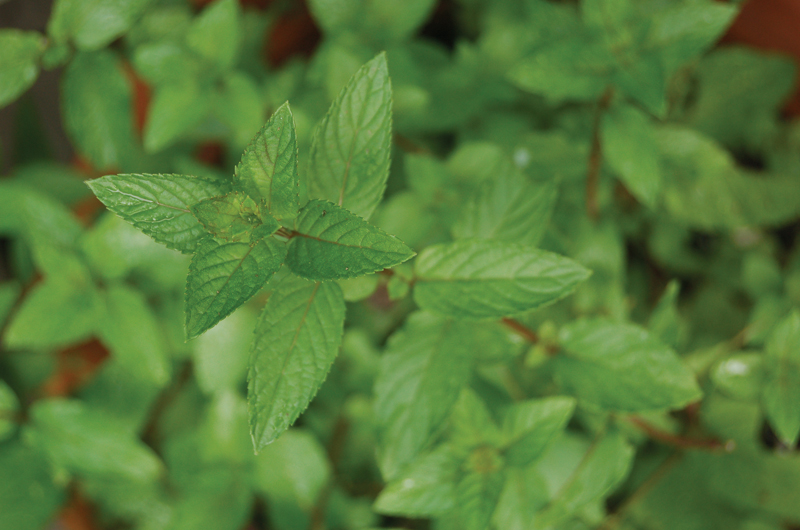“If I ever go looking for my heart’s desire again, I won’t look any further than my own backyard.” So said Dorothy in The Wizard of Oz. This may be the best herbal wisdom ever unintentionally incorporated into a movie script – what many gardeners think when we step off of our porches on a spring day and look out at the beauty of garden gates, raised beds, and compost piles. For healing, the backyard is the most natural and logical place to begin, and many herbalists consider themselves “backyard herbalists” simply because that’s where the plants are. Rosemary, lavender, and lemon balm are right there when you need them, and plantain, yarrow, and red clover are scattered among the edges ready when you come looking.
Many Vineyarders feel comfortable snipping off leaves and berries for tasty summer snacks and salads. When I co-wrote a series of articles on wild edibles for this magazine in 2009 with West Tisbury cookbook author and chef Catherine Walthers, we enjoyed scouting for our favorite wild foods. But in addition to the edible plants, I wanted to showcase the myriad medicinal herbs cultivated or growing wild here, and help people gain a comfort level using herbs for first aid as well as food, as the Vineyard is an ideal harvesting ground for botanical therapy.
I relish exploring the wilds of nature and connecting with new plants. I imagine this is what Chilmark farmer and herbalist Rebecca Gilbert meant when she told me she once introduced a man to the echinacea flower and taught him how to dig the root. “Now he has a connection with that plant,” she said. “That’s much more important than simply buying a tincture.”
Sometimes in my quest to identify nature’s bounty, I stretch the boundaries of safety and do something a little risky – such as taste a wild plant without being sure exactly what it is. I’d be horrified if my thirteen-year-old son did this (he loves to forage for wild foods too), and he’d get an earful about the dangers of picking willy-nilly without a proper ID from a reputable guidebook. But I do it myself occasionally after I’ve observed all of the other physical aspects of the plant. One in particular caught my eye after hiking near Lucy Vincent Beach in Chilmark: a silvery gray, spiky-looking specimen that was just un-weedy enough it could pass for a wildflower. After rubbing a leaf between my fingers and smelling the divine fragrance, I threw caution to the wind and nibbled it, discovering to my delight that it was a type of mint.
For backyard gardeners and foragers, mint is one of the easiest and most rewarding to harvest and use. In my book The Essential Herbal for Natural Health: How to Transform Easy-to-Find Herbs into Healing Remedies for the Whole Family (Shambhala Publications, 2012), you’ll learn that the best herbs to begin with are those that are common, safe, and versatile. Mint meets all these qualifications, and it’s tasty too.
Mint
Though it prefers moist earth, mint will grow just about anywhere, thriving in open, sunny places as well as quiet, secluded shadows. It likes the rich, wet soils of Chilmark but also grows in the dry hardpan of downtown Vineyard Haven. It’s great for erosion control, growing thickly and creating a strong system of runners underground, with fragrant leaves and tiny violet-hued petals above ground. It helps keep down weeds, attracts honeybees, and is edible and medicinal. Word of caution, however: In ideal growing conditions, mint can be invasive, and if gardening in a small space, it’s wise to keep it contained.
Mint seems to induce a certain surge of energy in the body, which has contributed to its worldwide popularity. It appears in diverse culinary and medicinal applications: from Morocco, where it’s a staple in tea, to Mexico, where herba buena is that country’s mint of choice for ointments. I like to say mint is the Buddha of the plant world, the bodhisattva, the healer who can transport us toward knowledge and wisdom. And, of course, it makes a great tea.
The most common types are native wild or field mint (Mentha arvensis), and escaped-from-cultivation peppermint (Mentha piperita) and spearmint (Mentha spicata). All mints are easy to recognize simply by their shape and smell. They have square stems (not round); their leaves are generally small ovals with tiny serrations on the edges; and they smell minty, sometimes with hints of wintergreen, lemon, chocolate, or apple. Peppermint is generally sharper, while spearmint is sweeter.
Spearmint is useful for digestive upset and as a tea-blend ingredient. It’s a wonderful colic remedy for babies, a soothing stomach-ache reliever, and a remedy for flatulent dyspepsia. It helps relieve nausea. I use antiseptic and antibacterial peppermint in tinctures for digestive upset and circulatory remedies, and to treat chronic lethargy, cardiac insufficiency, and mild depression. Both are good nervine tonics for relieving anxiety and maintaining focus.
And of course, mint is a delicious food, high in vitamin A with a moderate vitamin C content. It also makes a lovely syrup – easy, tasty, and useful as a sweetener. As a cooling herb, it soothes sunburned skin and makes a refreshing iced tea for hot summer days. It’s a great addition to internal remedies for the common cold, fever, and influenza, as well as external remedies for wounds and scrapes. Since it rejuvenates as it soothes, mint makes a fabulous foot balm. In short, good for you from head to toe.
Recipes from The Essential Herbal for Natural Health
Menemsha Mint Tea
One of the most popular tea blends of Holly’s Vineyard Herbs Teas & Apothecary.
Combine 2 tablespoons dried peppermint, 2 tablespoons dried spearmint, and 2 tablespoons dried hibiscus. Place the herbs in a teapot and pour 1 quart boiling water over them. Steep for 5 to 8 minutes, covered. Strain the tea, and sweeten it lightly as desired.
Summer Mint Ice Cubes
Almost any herb or flower can go into these lovely ice cubes to grace a pitcher or glass of water, lemonade, tea, or punch. Part of your harvest is for flavoring, and part is reserved for its visual appeal.
Gather 3 cups small leaves or flowers (such as peppermint, spearmint, lemon balm, or apple mint). Place 2 cups of the herbs into a teapot or a pan, and pour 2 cups boiling water over them. Steep, covered, for 8 to 10 minutes. Strain the liquid and return to the pot. Cover and allow to cool. Pour the tea into ice cube trays and place them in the freezer. After about 20 minutes, pull the trays out; as they begin to freeze, insert one fresh leaf or flower into each cube. Return the trays to the freezer. Serve the ice cubes in individual glasses for cold drinks, or add them to a large glass pitcher of your favorite beverage.
Peppermint-Ginger Pancake Syrup
This is a warming, stimulating, and fragrant syrup with a little zing. It’s wonderful as a pick-me-up for cold winter mornings.
In a large saucepan, combine 1/2 cup fresh chopped peppermint leaves, 1/2 cup fresh chopped ginger, and 3 cups water. Bring to a boil, then lower the heat and simmer until the volume has decreased to approximately 1 cup. This creates a strong, fragrant tea. Strain the liquid and return it to the pot. Add 1/2 cup honey or sugar, and heat gently until completely blended. Store syrup in a jar in the refrigerator.







